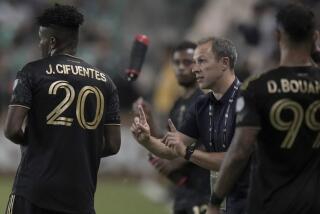Coyotes Discover Their Desert Oasis
After more than seven years in the desert, the Phoenix Coyotes are about to move into a place they can call their own.
The Glendale Arena -- no naming rights deal yet -- will open Saturday in the West Valley, on the edges of Phoenix’s urban sprawl. The Coyotes will no longer be the second banana they were at America West Arena, which wasn’t designed for hockey and had more than 4,200 obstructed-view seats. Under terms of a lease they signed hastily when they fled Winnipeg, they got no revenue from advertising, suites or concessions and couldn’t hold game-day skates on their home ice.
For the record:
12:00 a.m. Dec. 25, 2003 For The Record
Los Angeles Times Thursday December 25, 2003 Home Edition Main News Part A Page 2 National Desk 1 inches; 39 words Type of Material: Correction
Hockey -- The dates of goalie John Blue’s National Hockey League career were reported incorrectly as the mid-1980s in a Sports article Tuesday about the NHL. Blue’s career started in the 1992-93 season and ended in the 1995-96 season.
They hope the new, 17,799-seat arena, for which they contributed $40 million of the $220-million cost, will cut losses that have exceeded $20 million a year and boost their revenues “monumentally,” General Manager Mike Barnett said.
“We certainly haven’t been in a favorable situation in America West as a tenant,” he said. “Now we’re the landlord and tenant.”
The city of Glendale owns the arena, but the Coyotes will pay nominal rent and will manage it. Majority owner Steve Ellman, a developer, planned the arena at the center of a complex that will include a stadium for the NFL Cardinals, homes, shops, theaters and restaurants. For the immediate future, parking will be free for all events.
“It’s really a win-win for the city of Glendale and the Coyotes’ organization,” Barnett said. “Hopefully, they recover the money [the city invested] through sales tax and the wisdom of Steve Ellman in putting the arena there is justified. It’s going to be an entertainment destination.”
The arena will have 92 suites, of which 85% are sold, according to Barnett. The lower-bowl seats will pick up the brick red in the team’s new uniforms and the exterior will be what he called “desert colors” -- browns, reds and rust. The home opener is sold out and games against the Detroit Red Wings and New York Rangers are near-sellouts. The Coyotes requested a road-heavy early schedule and will play 28 games in their new home.
“It’s a nice building, intimate,” said Cliff Fletcher, the club’s senior executive vice president of hockey operations. “It’s going to have a great hockey atmosphere.”
Barnett said the Coyotes borrowed ideas from many arenas, such as the lighting at Staples Center, but wanted something unique.
“A building the magnitude of Staples Center or American Airlines [Center, in Dallas] wasn’t in the plans,” he said. “We wanted something designed and built, first and foremost, for hockey. It has all the amenities of the newest arenas today and the feeling of the Original Six hockey buildings: Steep at the ends, a low ceiling and, hopefully, lots of noise.”
The Coyotes will practice and train in Glendale, which they couldn’t do at America West.
“To my knowledge, it’s the biggest training facility of any NHL arena today,” Barnett said. “Fifteen years ago, a team might have had two or three bikes for players to ride. Now, we have 24 bikes and can ride as a team so they can get their cycling in as a unit.”
Now they have to prove the team that rides together, wins together.
California Dreaming
The list of California-born or -bred NHL players was longer than most fans realized even before La Verne native Noah Clarke made his King debut last week.
Reader Craig Greeley of Hermosa Beach pointed out that before Brea-raised Richard Park had made it to the NHL, Craig Coxe of Chula Vista played 235 NHL games and Matt Hervey of Whittier played 35 games for Winnipeg, Boston and Tampa Bay.
Before them, John Blue of Huntington Beach played 46 games in goal for the Boston Bruins and Buffalo Sabres in the mid-1980s. Long Beach native Ralph Barahona played six NHL games with Boston in the early 1990s and is now coach of the bantam AA team of the L.A. Junior Kings program. He was quite a roller hockey player, too, winning several world titles.
Also a coach for the L.A. Junior Kings is Nick Vachon, son of former King and NHL goalie Rogie Vachon. Nick grew up in Los Angeles and played several seasons in the minor leagues but only one game in the NHL, with the New York Islanders.
In addition, Chris Chelios played for the Los Angeles Hockey Assn. while his parents lived in San Diego. He later refined his game playing for junior-level Moose Jaw and at the University of Wisconsin.
Slap Shots
Flyer General Manager Bob Clarke grew irate last week when asked if he would trade for a goalie. The holiday trade freeze ends Saturday.
“I don’t know where you guys get this goaltender [nonsense],” Clarke said. “We’ve got one great goaltender in the NHL and his name is Martin Brodeur. The rest of them are good. You think New Jersey’s going to trade Martin Brodeur? I don’t think so.”
But that didn’t stop rumors about his wanting to trade Mike Comrie, whom he acquired from Edmonton and signed to a one-year, $1.75-million contract last week, to Phoenix for Sean Burke.
Coyote GM Barnett denied it, saying, “It’s never even been discussed.”
Peter Laviolette, who succeeded Paul Maurice as coach in Carolina last week, wants his team to quicken its tempo and encourages defensemen to join the play. The low-scoring Hurricanes haven’t swamped opponents yet but remain within reach of an East playoff spot.
“Change can provide an opportunity,” Laviolette told players. “A change could be a great thing.”
Bruin owner Jeremy Jacobs told the Boston Globe last week he “wouldn’t want to be Mike O’Connell right now,” and is expecting changes to be made to the slumping Bruins.
O’Connell, the general manager, agreed that if he were Jacobs, he “wouldn’t want to be me.”
Once these identity crises are sorted out, the Bruins can focus on restoring the grit and work ethic they’ve recently lacked. Joe Thornton can’t carry them himself.
If the Sabres’ swoon continues -- they’ve lost seven straight and eight of nine since peaking at 12-11-2-1 -- Coach Lindy Ruff and General Manager Darcy Regier might be gone. Regier said last week he had talked about trading unproductive winger Miroslav Satan, who was exiled by Ruff to fourth-line duty, but Satan’s $5-million salary makes him tough to move.
Rob Zamuner, once so hot a commodity he was picked for the 1998 Canadian Olympic team, was waived by the Bruins last week. A few hours later, he broke his nose. Altogether, a forgettable day.
More to Read
Go beyond the scoreboard
Get the latest on L.A.'s teams in the daily Sports Report newsletter.
You may occasionally receive promotional content from the Los Angeles Times.







